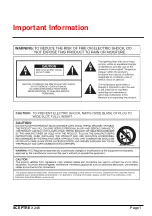
The power button features dual-illumination (bright and dim). In installations
where the unit is not wired for Stand-by operation and power is applied to the
unit, the Power Button will dimly glow when the unit is off, allowing the user
to easily find the control in low light. Illumination switches to full intensity
when the unit is turned on.
2. Source Input Select Button
This control toggles the active display image back and forth between AV1,
AV2 or AV3 inputs.
3. Day/Night Mode Button
This control toggles the unit between “Day” and “Night” LCD illumination
modes. In the “Day” mode, the LCD backlight intensity is at maximum. In
“Night” mode, the LCD backlight is dimmed to a preset level that is more
suitable for low light operation.
4. Picture Adjustment Menu Button
This control accesses an On-Screen-Display (OSD) menu for four LCD picture
adjustments (Brightness, Contrast, Color, and Tint). The first depress of the
button accesses the “Brightness” adjustment. The /- controls adjust
the level, which is indicated by the bar graph at the bottom of the screen. Each
consecutive depress of the Picture button accesses the adjustment screen for
each picture adjustment. If no buttons are pressed within 6 seconds or controls
other than the Picture and Volume buttons are pressed, the unit will exit the
Picture Adjustment mode.
5. /- Buttons
This 2-button set of controls adjusts the output volume of the built-in audio
speaker when the audio function is enabled *(see typical system connection
diagram). The “+” button increases output volume. The “-” button decreases
output volume. Volume level is indicated by the OSD bar graph at the bottom
of the screen.
These buttons also serve as adjustment controls while in the Picture Adjustment
Menu mode (see above section for details).
*Note: The AOM703 re12V to be applied to the “Audio Enable” trigger
input in order to activate the built-in speaker. If no audio output is heard from the
speaker regardless of the volume level adjustment, check this connection.
–
+
S
S
5































